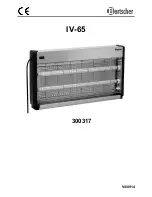
9640A
Instruction Manual
5-54
Alternatively, the UUT units selection may be changed to V rms to display
targets and adjust output values directly in rms voltage. Press the
Units
key
and select the required units.
Note
Measurements made on the 5790A 2.2 mV range (at levels below -40 dBm)
require correction for the 2.2 mV range linearity error.
8.
Repeat steps 6 and 7 for all points requiring the use of the AC Measurement Standard
(the UUT text box states
Use Precision AC Voltmeter)
. Set the UUT to
STBY
.
9.
Disconnect the AC Measurement Standard and 50
Ω
feedthrough termination from
the UUT base unit. Connect the UUT SMA output directly to the input of the 50
Ω
low-power (diode) sensor. Do not use a cable between the UUT SMA connector and
the power sensor input.
Note
Throughout the course of the calibration adjustment, the UUT internally
accounts for values previously adjusted using one reference instrument in
order to accomplish accurate transfers to other reference instruments.
10.
Set the UUT to
OPER
.
11.
Enter the measurement frequency corresponding to each
Target
into the power meter
to enable cal factor (frequency) correction.
Note
The recommended power meter has power sensor calibration factors stored
internally in the sensor. Setting the input frequency in the power meter
automatically selects the appropriate cal factor for the measurement.
However, the power sensor may also be accompanied by a table of
calibration factors which must be applied externally.
Note
The diode-based power sensor may exhibit frequency dependent linearity
errors, and additional corrections for these errors must also be applied.
Note
The power meter autorange boundary may coincide with a measurement
point. To avoid unwanted power meter autoranging during the adjustment
process, manually lock the power meter range when the UUT indicates the
current adjustment point is a Transfer Point and maintain the power meter
range lock for all frequencies at that amplitude. When the sequence reaches
the next Transfer Point allow the power meter to autorange and then
manually lock the power meter range again, continuing in this fashion for
all points requiring use of the power meter.
12.
Using the blue arrow keys and rotary knob, edit the UUT
Actual
output until the
power meter indicates the
Target
value stated. Press
Accept Target
.
13.
Press
Next Target
.
14.
Repeat steps 11 through 13 for all points requiring the use of the power meter and
sensor (the UUT text box states,
Use Power Meter
). Set the UUT to
STBY
.
15.
Disconnect the power meter and sensor from the UUT base unit. Connect the UUT
SMA output to the input of the spectrum analyzer/measuring receiver.
16.
Set the UUT to
OPER
.
Summary of Contents for 9640A Series
Page 8: ......
Page 16: ...9640A Instruction Manual viii...
Page 22: ...9640A Instruction Manual 1 2...
Page 40: ...9640A Instruction Manual 2 2...
Page 108: ...9640A Instruction Manual 4A 2...
Page 138: ...9640A Instruction Manual 4C 2...
Page 164: ...9640A Instruction Manual 4D 2...
Page 168: ...9640A Instruction Manual 4D 6...
Page 170: ...9640A Instruction Manual 4E 2...
Page 174: ...9640A Instruction Manual 4E 6...
Page 176: ...9640A Instruction Manual 4F 2...
Page 184: ...9640A Instruction Manual 4F 10...
Page 186: ...9640A Instruction Manual 4G 2...
Page 190: ...9640A Instruction Manual 4G 6...
Page 192: ...9640A Instruction Manual 5 2...
Page 272: ...9640A Instruction Manual 5 82...
Page 274: ...9640A Instruction Manual 6 2...
Page 284: ...9640A Instruction Manual 7 2...
Page 310: ...9640A Instruction Manual 8 2...
Page 316: ...9640A Instruction Manual 8 8...
Page 320: ...9640A Instruction Manual A 4...
















































